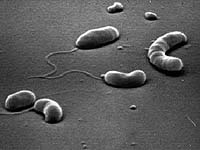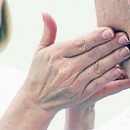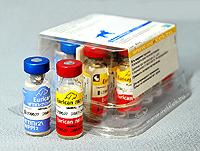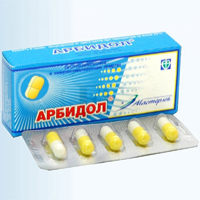Cholera is an acute infectious disease relating to particularly dangerous infections. Because of the ability in a short time, the significant number of people belongs to epidemic diseases. Learn more about cholera!
Content
What is cholera
 Cholera is an acute infectious disease relating to particularly dangerous infections. Due to the ability in a short time, hit a significant number of people (cause epidemics) and 50% mortality in the absence of treatment can be considered as biological weapons.
Cholera is an acute infectious disease relating to particularly dangerous infections. Due to the ability in a short time, hit a significant number of people (cause epidemics) and 50% mortality in the absence of treatment can be considered as biological weapons.
The cholera causative is a cholera vibrio (Vibrio Cholerae) - a slightly curved wand, remotely resembling comma. Vibriums are equipped with flavors, which allows them to move very quickly. Microorganism was opened by the famous German scientist Robert Koh in 1883.
There are two types of vibrions - classic and el - and both of them represent a danger to a person. They are part of the flora of many reservoirs, are found even in the Moscow River. The determining question is the number of these most vibrions per unit volume of water. In order to get a cholera, you need to swallow from a million to a trillion microorganisms.
Such a big scatter is explained by the extreme instability of the pathogen to hydrochloric acid, which is in our stomach. If the acidity is lowered (for example, in atrophically gastritis) or hydrochloric acid is considerably diluted (with a large amount of liquid), the amount of vibrions required for infection is reduced 100 thousand times.
Best of all the vibrine is multiplied at a temperature of 30-40°C, so it is especially much in the reservoirs of India, Asia and Africa. The causative agent almost instantly dies when boiling, at a temperature of 50°C - for 30 minutes. Does not make a microbe and drying, and the straight sun rays kill it within an hour.
On the surface of vegetables and fruits, for example, watermelons, the vibrion can live up to 5 days. The only source of proliferation of infection is a sick person or a vibriperoster from the region, disadvantaged on cholera, distinguishing pathogen with feces or vomit masses. This method of transmission epidemiologists is called fecal-oral.
What happens during cholera
The main events begin to develop in the human body when the critical mass of the vibrio is from the stomach in the small intestine. It is warm and humid here, the medium is already alkaline, which is quite suitable for mass reproduction of pest microorganisms.
The incubation period (the period from microbes from entering the body to the first manifestations of the disease) lasts from several hours to 2-3 days.
During its turbulent vital activity, vibriums produce toxin - cholerogen. This toxin causes intensive release of the liquid from the tissues into the lumen of the small intestine. And the most powerful, the so-called profuse diarrhea begins. And general intoxication causes indomitable vomiting. Man begins to pour a huge amount of liquid.
The severity of the manifestations of the disease depends on many factors - the state of the body, the number of causative agents inwards and T.NS. With erased forms, a single liquid chair is possible, as well as weak manifestations of intoxication. There is also an asymptomatic form of carriage - when a person does not feel sick, but it allocates a huge amount of pathogens into the external environment.
The classic cholera picture is frequent, up to 10 or more times a day, diarrhea. The loss of fluid is colossal - up to 20 liters per day, and each millilitress contains up to a billion vibrion.
As a result of massive loss of fluid, blood thickening and dehydration. The patient's condition is quick and sharply deteriorating. Due to loss with liquid microelements, muscle cramps appear, most often - starting with the calf muscles.
The features of the face are sharpened, the eyes are wade, lips and ear sinks. Cold skin (cholera - one of the few infections accompanied by a normal or even reduced body temperature). The skin loses its elasticity, it is easily going to the fold and very longs straightening back, and the skin stop and hands becomes wrinkled - the so-called «Hands lacker». Dyspnea appears, sharp weakness.
In the absence of treatment with modern means, half of the patients dies during the first day.
Treatment cholera
Treatment is carried out in infectious hospitals, although due to the rarity of the transmission of the disease directly from a patient with a person to a healthy experts of the World Health Organization (WHO), consider it possible to place such patients in ordinary therapeutic chambers. It should be noted that recently up to 90% of cholera proceeds in light form.
The basis of treatment is the replenishment of fluid loss and microelems, maintaining water-electrolyte and acid-alkaline balances in the body. Antibiotics - only an additional treatment, Vibrion is still sensitive to conventional tetracycline. Due to the complex therapy, the death rate from cholera currently does not exceed 1%.
Prevention cholera
Transferred infection does not leave after a resistant immunity, and the re-infection of cholera is possible in any period of life, and attempts to create an effective vaccine while barren. Effectiveness of vaccination is currently estimated at 25-50% with a duration of 3-6 months, although reports appeared and on creating a more efficient vaccine.
Basic prevention measures when visiting unfavorable cholera areas - Wash hands before eating and cooking, as well as after visiting the toilet. Only boiled water, vegetables and fruits after washing with running water must be loaded with boiling water; eliminate the purchase of products from random persons; swim only in permitted places.









